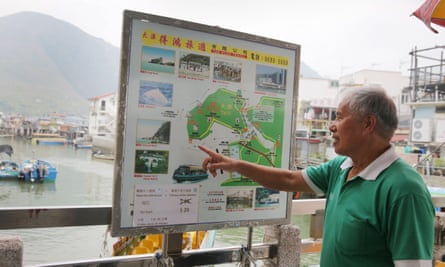Conservationists have warned that projects to expand Hong Kong’s airport and build a new bridge to Macau could result in the loss of the city’s beloved “pink” dolphins.
Dolphin numbers have declined sharply in Hong Kong harbour over the past few decades, and campaigners fear that the large-scale construction work will drive the mammals away for good.
The Chinese white dolphin – popularly known as the pink dolphin due to its pale pink colouring – draws scores of tourists daily to the waters north of Hong Kong’s Lantau island.
It became Hong Kong’s official mascot for the handover ceremony in 1997, when Britain returned the territory to China. But despite the affection felt towards the dolphin, there may soon be none left.
The proposed construction of a third runway at Hong Kong’s busy Chek Lap Kok airport could be the nail in the coffin, according to campaigners.
“We think that if that project goes ahead, then it will probably drive the dolphin away from Hong Kong waters,” said Samuel Hung, chairman of the Hong Kong Dolphin Conservation Society, who has been going out to sea at least twice a week to monitor dolphin activity for almost 20 years.
“In some ways it seems like we are pushing them closer and closer to the edge of the cliff and if we’re making that final push, they will be gone forever. I think now is the time to get our act together.”
Hung says there are only around 60 dolphins left in Hong Kong waters – a drop from 158 in 2003.
“The dolphin decline is caused by a number of factors, including overfishing and environmental pollution... but I think the major contribution is coming from the increase of high-speed ferry traffic,” Hung said.
The dolphins have either gone to neighbouring Chinese waters or may have died off, he said.

Dolphin habitats have already been affected by the ongoing construction of a 50km bridge connecting Hong Kong to the gambling enclave of Macau.
The bridge looms on the horizon behind the village of Tai O, on the western tip of Lantau island, from where dozens of dolphin tours go out daily.
“Since the construction of the bridge in 2012 the situation has worsened,” says Hung, who blames land reclamation encroaching on dolphin habitats and continuing construction creating disturbance.
The WWF recently placed volunteers on the dolphin-spotting boats to tell tourists about the problems the animals are facing.
“Pollution is quite serious in the air and water... We worry about the marine life being affected,” said Hong Kong bank worker Yeung Ka-yan, 30, after taking a short boat trip.
“We were a little disappointed,” added her boyfriend, a 26-year-old chef from Taiwan, after failing to spot any dolphins – a scenario that could become all too common in the years ahead if conservationists’ fears are realised.
Dolphin-watching accounts for 10 % of Tai O’s tourism business.
The government said that potential impacts the proposed third-runway could have on the pink dolphins had been “properly assessed and addressed”.
“To compensate for the permanent loss of Chinese white dolphin habitats arising from the land formation works, the designation of a new marine park of approximately 24ha in the waters north of the third-runway project has been proposed,” the statement from the agriculture, fisheries and conservation department said.
But campaigners criticised the plan, saying the marine park would not be established until at least 2023, when reclamation work for the third runway is expected to finish.
“We don’t even know whether the dolphin can hang on and survive and wait,” Hung said.
“We have been following some of them for nearly 20 years so those are our old friends.
“They don’t realise that there is more disaster waiting for them.”

Comments (…)
Sign in or create your Guardian account to join the discussion